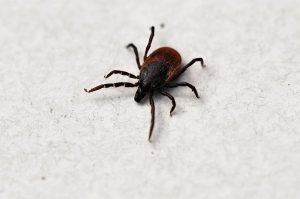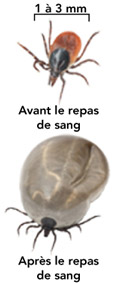Treatment
Preventive treatment
If you were bitten by a tick in some sectors of the Estrie, Montérégie, Outaouais or Mauricie-et-Centre-du-Québec regions, preventive treatment with antibiotics could be prescribed for you in some situations.
For more information on the situation in these four regions, go to the regional websites:
If you were bitten by a tick elsewhere in Québec, preventive treatment with antibiotics is generally not recommended. However, you must watch for symptoms to appear. If you were bitten by a tick elsewhere in Canada or in the United States, in zones where there is a high risk of contracting the disease, preventive treatment with antibiotics could also be prescribed for you.
To find out if it is preferable to consult a healthcare professional, contact Info-Santé 811.
Even if you receive preventive treatment, it is important to watch for the development of symptoms of Lyme disease in the months after being bitten.
Treatment of the disease
Lyme disease can be treated with antibiotics prescribed by a doctor. The nature and duration of the treatment depends on the stage of infection and symptoms.
People who are treated usually experience a quick and full recovery from the disease. Some, however, may have symptoms for several months.
Complications
If the disease is not detected and treated quickly, it can cause problems in other organs or parts of the body, for example:
- Joint problems
- Heart problems
- Neurological problems
These problems may appear within the weeks or months after you are bitten.
Transmission
To transmit the disease, the tick must carry Borrelia burgdorferi bacteria. After a tick bite, the risk of developing Lyme disease is very low if the tick remains attached to the skin for less than 24 hours, even if you were bitten in a high-risk sector. However, the risk increases if the tick remains attached for longer. It is, as a result, vital to remove the tick from your skin as quickly as possible. For more information, visit our Removing a tick after a bite page.
Ticks can cling to any part of the human body. They are often found in areas that are difficult to inspect, such as:
- The groin
- The navel
- The armpits
- Inside or around the ears
- Behind the knees
- The bottom of the buttocks
- The lower back
- The hair
Pets who go outdoors can also bring ticks into the home.
People with Lyme disease can contract it again.
Lyme disease cannot be transmitted from an infected animal to a human or through contact between 2 people.
Protection and prevention
Ticks do not jump, do not fly and do not drop from a height (for example, from a branch). They can, however, cling to you or your pet when you are in contact with plants in a garden, in landscaping, in the forest, in wooded areas and in tall grass. The best way to prevent Lyme disease is to avoid tick bites during outdoor activities such as gardening, walks in the forest, golf, hunting, fishing, camping, etc.
Precautions
How to avoid tick bites
- Take your walks preferably on trails and avoid tall grass.
- Use insect repellent on every exposed part of your body, avoiding your face. Closely follow the instructions for using mosquito repellent.
- Wear a hat, closed shoes, a long-sleeved shirt and long pants.
- Tuck your shirt into your pants.
- Tuck your pants into your socks or boots.
- After outdoor activities :
- Take a bath or a shower as soon as possible, ideally within 2 hours after the outdoor activity, to check for the presence of ticks (see below). This will also allow you to remove ticks not solidly attached to the skin
- Carefully inspect your belongings (backpack, coat, etc.). This precaution seeks to avoid introducing a tick into your home, where it could bite a person or a pet.
- Eliminate ticks on your clothes by putting them in the dryer at high temperature for 10 minutes. If your clothes are too dirty to be put in the dryer directly, wash them in the machine with hot water, ideally for at least 40 minutes. Then put them in the dryer at high temperature for at least 60 minutes. The clothes must be completely dry.
- Also inspect your pets as they may bring ticks into your house. If you find ticks on a pet, remove them and consult a veterinarian if necessary. To obtain information and recommendations regarding ticks on your pets, consult the Ministère de l’Agriculture, des Pêcheries et de l’Alimentation website.
How to spot a tick on your body
- Wear bright-coloured clothing during your walks. Clear colors make ticks more visible.
- Examine your entire body after an outdoor activity. Ideally take a bath or a shower within 2 hours after the outdoor activity. Have another person help you or use a mirror to examine the least visible parts, such as the back. Also use shower time to examine your kids. If you find a tick, remove it by following instructions indicated in Removing a tick after a bite.
To reduce the presence of ticks in your surroundings
- Cut tall grass and undergrowth around your house, and mow your lawn
- Remove dead leaves, undergrowth and weeds from your lawn, around wood supplies and the shed
- Place wood chip or gravel paths between lawns and wooded areas, patios and playgrounds. Paths should be at least 3 meters in width
- Position play areas away from trees, in a sunny location
- Stack wood neatly in a dry, sheltered area. This can deter rodents, which attract ticks. Rid your yard of old furniture and items.
Special conditions
In Québec, it has been mandatory to report Lyme disease infection cases since 2003. Any laboratory staff member or doctor who diagnoses the disease must notify the public health authorities.


